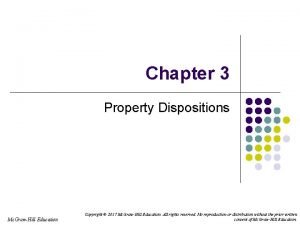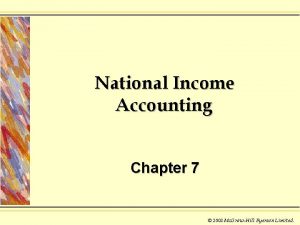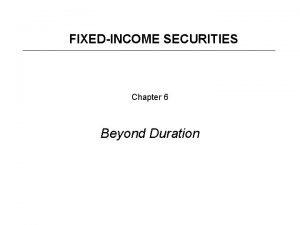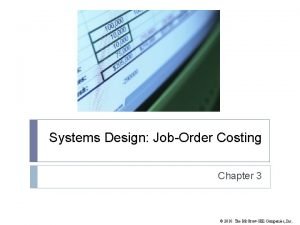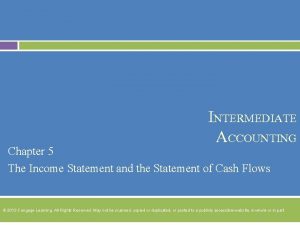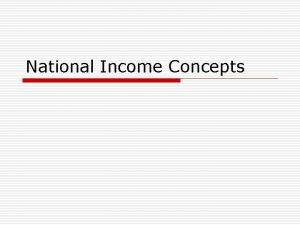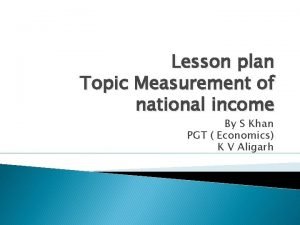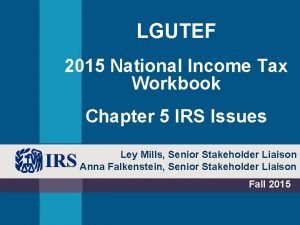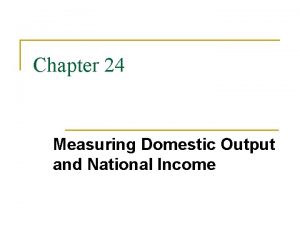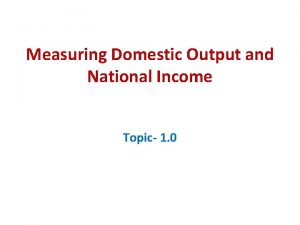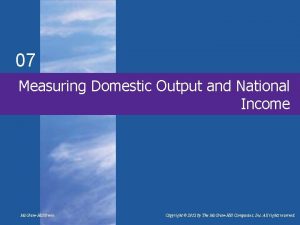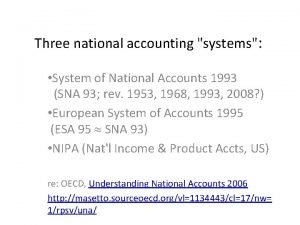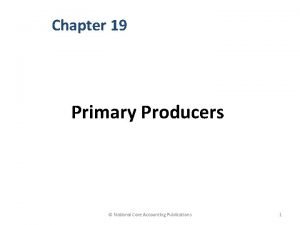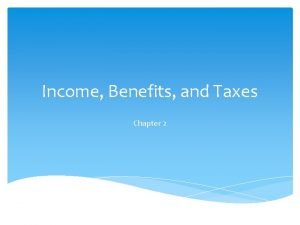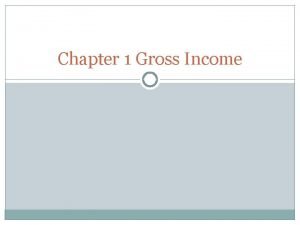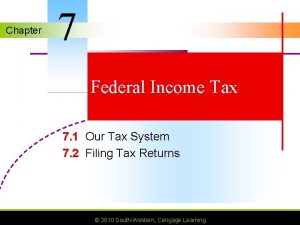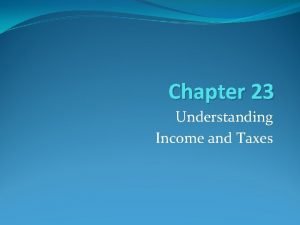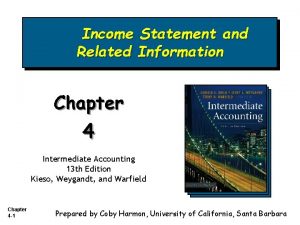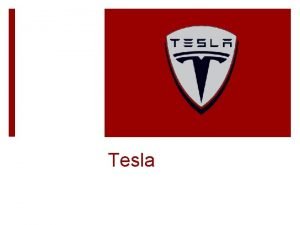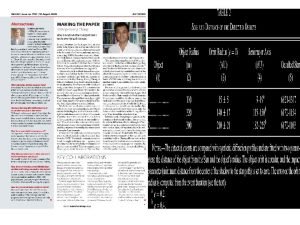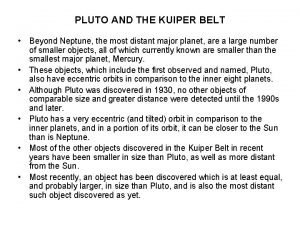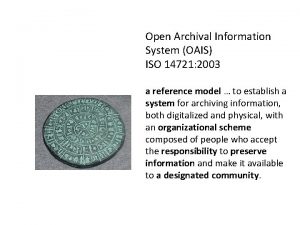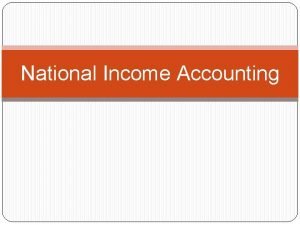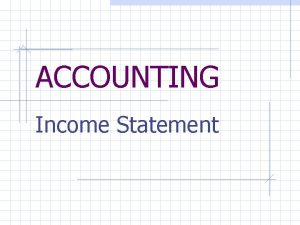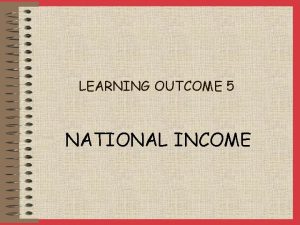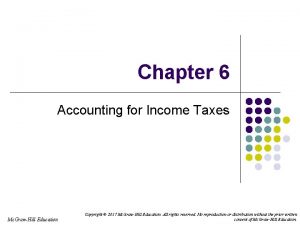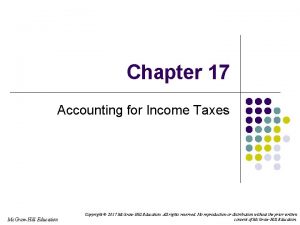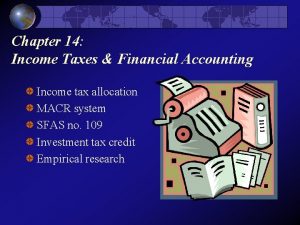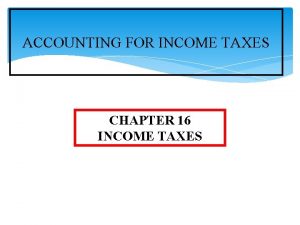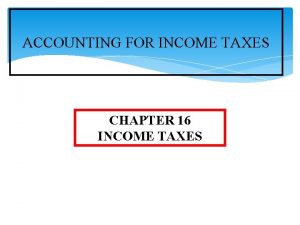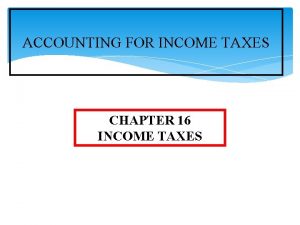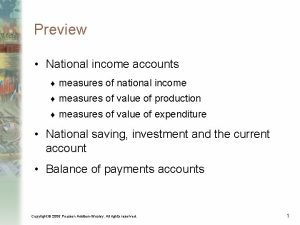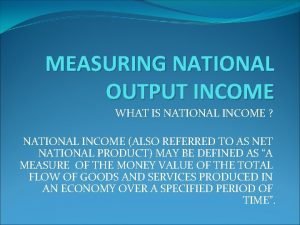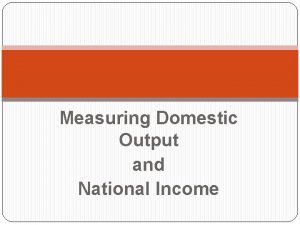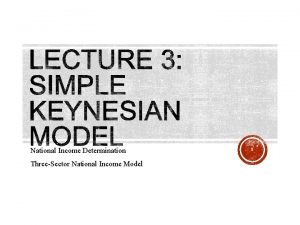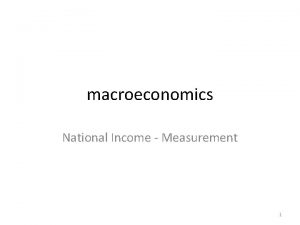National Income Accounting Chapter 7 2003 Mc GrawHill









































































- Slides: 73

National Income Accounting Chapter 7 © 2003 Mc. Graw-Hill Ryerson Limited.

7 -2 Laugher Curve Three econometricians went out hunting, and came across a large deer. The first econometrician fired, but missed, by a meter to the left. © 2003 Mc. Graw-Hill Ryerson Limited.

7 -3 Laugher Curve The second econometrician fired, but also missed, by a meter to the right. The third econometrician didn't fire, but shouted in triumph, "We got it!" © 2003 Mc. Graw-Hill Ryerson Limited.

7 -4 National Income Accounting u In the 1930 s it was impossible for macroeconomics to exist in the form we know it today because many aggregate concepts had not yet been formulated, or were lacking rigour. © 2003 Mc. Graw-Hill Ryerson Limited.

7 -5 National Income Accounting u In the mid-1930 s, two Keynesians, Simon Kuznets and Richard Stone, began to develop this terminology. © 2003 Mc. Graw-Hill Ryerson Limited.

7 -6 National Income Accounting u They developed national income accounting – a set of rules and definitions for measuring economic activity in the aggregate economy – that is, in the economy as a whole. © 2003 Mc. Graw-Hill Ryerson Limited.

7 -7 Measuring Total Economic Output of Goods and Services Gross Domestic Product (GDP) is the total market value of all final goods and services produced in an economy in a one-year period. u It is the single most-used economic measure. u © 2003 Mc. Graw-Hill Ryerson Limited.

7 -8 Measuring Total Economic Output of Goods and Services u Gross National Product (GNP) is the aggregate final output of citizens and businesses of an economy in one year. © 2003 Mc. Graw-Hill Ryerson Limited.

7 -9 Measuring Total Economic Output of Goods and Services GDP measures the economic activity that occurs within a country. u GNP measures the economic activity of the citizens and businesses of a country. u © 2003 Mc. Graw-Hill Ryerson Limited.

7 - 10 Measuring Total Economic Output of Goods and Services u Net foreign factor income is added to GDP to create the GNP. foreign factor income is the income from foreign domestic factor sources minus foreign factor incomes earned domestically. l In other words, we must add the foreign income of our citizens and subtract the income of residents who are not citizens. l Net © 2003 Mc. Graw-Hill Ryerson Limited.

7 - 11 Calculating GDP u Calculating GDP requires adding together million of goods and services. u All goods and services produced by an economy must be weighted, that is, each good and service must be multiplied by its price. © 2003 Mc. Graw-Hill Ryerson Limited.

7 - 12 Calculating GDP Once quantities of a particular good or service are multiplied by its price, we arrive at a value measure of the good or service. u Finally, all the value measures are added to calculate that year’s GDP. u GDP is a flow measure (an amount per year). u © 2003 Mc. Graw-Hill Ryerson Limited.

7 - 13 GDP is a Flow Concept u GDP is a measure of final output per year – it is a flow concept, not a stock (an amount at a particular moment in time). © 2003 Mc. Graw-Hill Ryerson Limited.

7 - 14 GDP is a Flow Concept The store of wealth, in contrast, is a stock concept. u The stock equivalent to national income accounts is the national balance sheet – a balance sheet of an economy’s stock of assets and liabilities. u © 2003 Mc. Graw-Hill Ryerson Limited.

7 - 15 Canadian Financial Flows, Fig. 7 -1, p 165 © 2003 Mc. Graw-Hill Ryerson Limited.

7 - 16 GDP Measures Final Output GDP does not measure total transactions in the economy. u It counts final output but not intermediate goods. u © 2003 Mc. Graw-Hill Ryerson Limited.

7 - 17 GDP Measures Final Output Final output – goods and services purchased for final use. u Intermediate products are used as inputs in the production of some other product. u © 2003 Mc. Graw-Hill Ryerson Limited.

7 - 18 GDP Measures Final Output Counting the sale of final goods and intermediate products would result in double and triple counting. u If we did not eliminate intermediate goods, a change in organization—say, a merger—would look like a change in output. u © 2003 Mc. Graw-Hill Ryerson Limited.

7 - 19 Two Ways of Eliminating Intermediate Goods There are two ways of eliminating intermediate goods. u The first is to calculate only final sales. u © 2003 Mc. Graw-Hill Ryerson Limited.

7 - 20 Two Ways of Eliminating Intermediate Goods u A second way is to follow the value added approach. added is the increase in value that a firm contributes to a product or service. l It is calculated by subtracting intermediate goods from the value of its sales. l Value © 2003 Mc. Graw-Hill Ryerson Limited.

7 - 21 Value Added Approach Eliminates Double Counting, Table 71, p 166 © 2003 Mc. Graw-Hill Ryerson Limited.

7 - 22 Calculating GDP: Some Examples Selling your car to a neighbor does not add to GDP. u Selling your car to a used car dealer who sells your car to someone else for a higher price, does add to GDP. u The value added is the dealer's services. u © 2003 Mc. Graw-Hill Ryerson Limited.

7 - 23 Calculating GDP: Some Examples Selling a stock or bond does not add to GDP. u The stock broker's commission for the sales does add to GDP. u © 2003 Mc. Graw-Hill Ryerson Limited.

7 - 24 Calculating GDP: Some Examples Pension payments, welfare payments, employment insurance benefits, and other government transfer payments are not included in GDP. u The work of unpaid house spouses does not appear in GDP calculations. u © 2003 Mc. Graw-Hill Ryerson Limited.

7 - 25 Two Methods of Calculating GDP There are two methods of calculating GDP: the expenditure approach and the income approach. u This is because of the national income accounting identity. u © 2003 Mc. Graw-Hill Ryerson Limited.

7 - 26 The National Income Accounting Identity The equality of output and income is an accounting identity in the national income accounts. u The identity can be seen in the circular flow of income in an economy. u © 2003 Mc. Graw-Hill Ryerson Limited.

7 - 27 The Circular Flow, Fig. 7 -2, p 169 Wages, rents, interest, profits Factor services Household Imp Goods Firms t n e m n (production) r e v o Government g G endin Taxes Sp tment Savin gs Financial markets Inves orts Personal consumption Other countries rts o p x E © 2003 Mc. Graw-Hill Ryerson Limited.

7 - 28 The Expenditure Approach The expenditure approach is shown on the bottom half of the circular flow. u Specifically, GDP is equal to the sum of the four categories of expenditures. u GDP = C + I + G + (X - IM) © 2003 Mc. Graw-Hill Ryerson Limited.

7 - 29 Consumption u When individuals receive income, they can spend it on domestic goods, save it it, pay taxes, or buy foreign goods. © 2003 Mc. Graw-Hill Ryerson Limited.

7 - 30 Consumption is the largest and most important of the flows. u It is also the most obvious way in which income received is returned to firms. u © 2003 Mc. Graw-Hill Ryerson Limited.

7 - 31 Investment The portion of income that individuals save leaves the spending stream and goes into financial markets. u Business spending on equipment, structures, and inventories is counted as part of gross private investment, together with household spending on new owner-occupied housing. u © 2003 Mc. Graw-Hill Ryerson Limited.

7 - 32 Investment Sooner or later, plant and equipment wears out. u This wearing-out process is called depreciation – the decrease in an asset's value. u © 2003 Mc. Graw-Hill Ryerson Limited.

7 - 33 Investment Economists differentiate between total or gross private domestic investment and the new investment that is above and beyond replacement investment. u Net private investment – gross private investment less depreciation. u © 2003 Mc. Graw-Hill Ryerson Limited.

7 - 34 Government Expenditures u When individuals pay taxes, those taxes are either spent by government on goods and services or are returned to individuals in the form of transfer payments. © 2003 Mc. Graw-Hill Ryerson Limited.

7 - 35 Government Expenditures u Government payments for goods and services or investment in equipment and structures are referred to as government expenditures. © 2003 Mc. Graw-Hill Ryerson Limited.

7 - 36 Government Expenditures There is a connection between the government and the financial markets. u If the government runs a deficit, it must borrow from financial markets to make up the difference. u © 2003 Mc. Graw-Hill Ryerson Limited.

7 - 37 Net Exports u Spending on foreign goods escapes the system and does not add to domestic production, thus spending on imports are subtracted from total expenditures. © 2003 Mc. Graw-Hill Ryerson Limited.

7 - 38 Net Exports to foreign nations are added to total expenditures. u These flows are usually combined into net exports (exports minus imports). u © 2003 Mc. Graw-Hill Ryerson Limited.

7 - 39 GDP and NDP u Net domestic product (NDP) is the sum of consumption expenditures, government expenditures, net foreign expenditures, and investment less depreciation. © 2003 Mc. Graw-Hill Ryerson Limited.

7 - 40 GDP and NDP u Net domestic product is GDP adjusted for depreciation: GDP = C + I + G + (X - IM) NDP = C + I + G + (X - IM) - Depreciation © 2003 Mc. Graw-Hill Ryerson Limited.

7 - 41 GDP and NDP u NDP is actually preferable to GDP as an expression of a nation's domestic output. © 2003 Mc. Graw-Hill Ryerson Limited.

7 - 42 GDP and NDP u Since it is so hard to measure depreciation in the real world, economists use capital consumption allowance rather than depreciation. © 2003 Mc. Graw-Hill Ryerson Limited.

7 - 43 Expenditure Breakdown of GDP for Selected Countries, Table 7 -2, p 171 Personal consumptio n (%of GDP) Gross private investment (% of GDP) Government expenditures (% of GDP) Exports (% of GDP) Imports ( -% of GDP) 750 58 18 19 42 -37 10, 198 69 16 18 10 -13 760 64 21 16 10 -11 Germany 2, 081 58 21 19 27 -25 Japan 4, 395 60 29 10 11 -10 Pakistan 60 78 15 11 15 -19 Tunisia 21 63 28 12 42 -45 9 72 18 13 20 -23 Country Canada U. S. Brazil Tanzania Nominal GDP (billions US$) © 2003 Mc. Graw-Hill Ryerson Limited.

7 - 44 The Factor Incomes Approach The income approach is shown on the top half of the circular flow. u Firms make payments to households for supplying their services as factors of production. u © 2003 Mc. Graw-Hill Ryerson Limited.

7 - 45 The Factor Incomes Approach National income is the total income earned by citizens and businesses of a country. u It consists of employee compensation, rent, interest, and profits. u When we add indirect taxes (less subsidies) and depreciation to nations income, we have GDP. u © 2003 Mc. Graw-Hill Ryerson Limited.

7 - 46 The Factor Incomes Approach Wages, salaries and supplementary labour income that firms pay to workers constitute the largest component of GDP. u Corporate profits before taxes are also included in income. u © 2003 Mc. Graw-Hill Ryerson Limited.

7 - 47 The Factor Incomes Approach u Interest and investment income measures the difference between interest payments that households receive on loans they have made, and interest payments that they make on borrowed funds. © 2003 Mc. Graw-Hill Ryerson Limited.

7 - 48 The Factor Incomes Approach Further included in incomes are those incomes earned by owner-operators. Rental income is included in this category. u Gains and losses from holding inventories have to be removed form calculation, as well as indirect taxes and subsidies, and depreciation. u © 2003 Mc. Graw-Hill Ryerson Limited.

7 - 49 Equality of Income and Expenditure Income and expenditures must be equal because of the rules of double-entry bookkeeping. u Profit is the balancing item. u © 2003 Mc. Graw-Hill Ryerson Limited.

7 - 50 Equality of Income and Expenditure u The national income accounting identity allows GDP to be calculated either by adding up all values of final output or by adding up the values of all earnings or income. © 2003 Mc. Graw-Hill Ryerson Limited.

7 - 51 Qualifications to the Income Accounting Identity u To go from GDP to national income: l Add net foreign factor income. National income is all income earned by citizens of a nation and is equal to GNP. u To move from "domestic" to "national" we add net foreign factor income. u l Subtract depreciation from GDP. l Subtract indirect business taxes less subsidies from GDP. © 2003 Mc. Graw-Hill Ryerson Limited.

7 - 52 Equality of Expenditure and Income, fig. 7 -3, p 174 Net foreign factor income Net exports Government expenditures Depreciation Indirect taxes-subsidies Inventory adjustment Farm income Investment Interest and investment income Consumption GNP GDP Profits before taxes National Income Wages and salaries (1) Expenditures = (2) Output = (3) Income © 2003 Mc. Graw-Hill Ryerson Limited.

7 - 53 Other Income Terms Other income terms are personal income and disposable personal income. u Personal income measures all income actually received by individuals. u © 2003 Mc. Graw-Hill Ryerson Limited.

7 - 54 Other National Income Terms Personal income (PI) is national income plus net transfer payments from government minus amounts attributed but not received. PI = NI + transfer payments from government - corporate retained earnings - corporate income taxes – employment taxes (CPP, EI) u © 2003 Mc. Graw-Hill Ryerson Limited.

7 - 55 Other National Income Terms Disposable personal income is personal income minus personal income taxes and payroll taxes. u Disposable personal income is what people have readily available to spend. u DPI = PI - personal taxes © 2003 Mc. Graw-Hill Ryerson Limited.

7 - 56 Using GDP Figures u GDP figures are used to make comparisons among countries and to measure economic welfare over time. © 2003 Mc. Graw-Hill Ryerson Limited.

7 - 57 Comparing GDP Among Countries GDP gives a measure of economic size and power. u Per capita GDP is another measure often used to compare various nations' income. u © 2003 Mc. Graw-Hill Ryerson Limited.

7 - 58 Comparing GDP Among Countries u Because of differences in nonmarket activities, per capita GDP can be a poor measure of the living standards in various nations. © 2003 Mc. Graw-Hill Ryerson Limited.

7 - 59 Comparing GDP Among Countries u To get around the problems of per capita GDP, economists use purchasing power parity (PPP), which adjusts for different relative prices among nations before making comparisons. © 2003 Mc. Graw-Hill Ryerson Limited.

7 - 60 Economic Welfare Over Time Just because GDP rose does not mean welfare rose—it could be that only prices rose. u Comparing output over time is best done with real output which is nominal output adjusted for inflation. u © 2003 Mc. Graw-Hill Ryerson Limited.

7 - 61 Real and Nominal GDP is GDP calculated at existing prices. u Real GDP is nominal GDP adjusted for inflation. u © 2003 Mc. Graw-Hill Ryerson Limited.

7 - 62 Real and Nominal GDP u Real GDP is important to society because it measures what is really produced. © 2003 Mc. Graw-Hill Ryerson Limited.

7 - 63 Real and Nominal GDP u Real GDP is calculated by dividing nominal GDP by the GDP deflator. © 2003 Mc. Graw-Hill Ryerson Limited.

7 - 64 Some Limitations of National Income Accounting u Although Canadian national income accounting statistics are among the most accurate in the world, they still have some serious limitations. © 2003 Mc. Graw-Hill Ryerson Limited.

7 - 65 GDP Measures Market Activity, Not Welfare GDP does not measure happiness, nor does it measure economic welfare. u Welfare is a complicated idea, very difficult to measure. u © 2003 Mc. Graw-Hill Ryerson Limited.

7 - 66 Measurement Errors u GDP figures do not measure all market economic activity. © 2003 Mc. Graw-Hill Ryerson Limited.

7 - 67 Measurement Errors u GDP figures do not measure: l Illegal drug sales. l Under-the-counter sales of goods to avoid income and sales taxes. l Work performed and paid for in cash. l Unreported sales. l Prostitution, loan sharking, extortion, and other illegal activities. © 2003 Mc. Graw-Hill Ryerson Limited.

7 - 68 Measurement Errors u Estimates of the size of the underground economy range from 1. 5 to 20 percent of GDP in Canada. © 2003 Mc. Graw-Hill Ryerson Limited.

7 - 69 Measurement Errors u A second type of measurement error occurs in adjusting GDP for inflation. l If the price and the quality of a product go up together, has the price really gone up? l Is it possible to measure the value of quality increases? © 2003 Mc. Graw-Hill Ryerson Limited.

7 - 70 Misinterpretation of Subcategories The subcategories of GDP can be misinterpreted. u For example, the line between investment and consumption is often fuzzy. u © 2003 Mc. Graw-Hill Ryerson Limited.

7 - 71 Misinterpretation of Subcategories Some social scientists have developed alternatives to GDP such as the Genuine Progress Indicator (GPI). u The GPI tries to measure pollution, education, health concerns, as well as GDP. u © 2003 Mc. Graw-Hill Ryerson Limited.

7 - 72 Conclusion National income accounting should be used with sophistication. u It is a powerful economic tool that informs average citizens about the direction of the economy. u © 2003 Mc. Graw-Hill Ryerson Limited.

National Income Accounting End of Chapter 7 © 2003 Mc. Graw-Hill Ryerson Limited.
 Deferred tax asset journal entry
Deferred tax asset journal entry Calculate income tax
Calculate income tax Value added approach formula
Value added approach formula Ano ang pormula sa pagsukat sa pamamaraan ng gastusin?
Ano ang pormula sa pagsukat sa pamamaraan ng gastusin? National income accounting equation
National income accounting equation Grawhill
Grawhill Grawhill
Grawhill Grawhill
Grawhill Grawhill
Grawhill Mc graw hill
Mc graw hill Single user multitasking os
Single user multitasking os Grawhill
Grawhill Mc grawhill
Mc grawhill Grawhill
Grawhill Chapter 19 accounting for income taxes
Chapter 19 accounting for income taxes Statement of comprehensive income
Statement of comprehensive income Financial accounting chapter 1
Financial accounting chapter 1 Income statement in financial accounting
Income statement in financial accounting Income accounting u of u
Income accounting u of u Fixed income accounting
Fixed income accounting Period cost
Period cost Intermediate accounting chapter 5
Intermediate accounting chapter 5 Sfas 109
Sfas 109 Nnp calculation formula
Nnp calculation formula National income and product accounts
National income and product accounts Lesson plan on national income
Lesson plan on national income National income formula
National income formula National income tax workbook
National income tax workbook Measuring domestic output and national income
Measuring domestic output and national income Solve the national income model by matrix inversion
Solve the national income model by matrix inversion National income data
National income data What is national income
What is national income Outputs
Outputs Measuring domestic output and national income
Measuring domestic output and national income Measuring domestic output and national income
Measuring domestic output and national income Accounting software conclusion
Accounting software conclusion What is the going concern assumption
What is the going concern assumption Limitations of responsibility accounting ppt
Limitations of responsibility accounting ppt National account systems
National account systems Microeconomics examples
Microeconomics examples Nature of accounting
Nature of accounting Panchayat accounting
Panchayat accounting National core accounting publications
National core accounting publications National unification and the national state
National unification and the national state Chapter 2 income benefits and taxes
Chapter 2 income benefits and taxes Margin of safety sales formula
Margin of safety sales formula Chapter 1 gross income
Chapter 1 gross income Chapter 1 gross income lesson 1.5 salary worksheet answers
Chapter 1 gross income lesson 1.5 salary worksheet answers Chapter 7 federal income tax
Chapter 7 federal income tax Chapter 23 understanding income and taxes
Chapter 23 understanding income and taxes Chapter 4 income statement and related information
Chapter 4 income statement and related information How your choices affect income
How your choices affect income Chapter 2 income sources
Chapter 2 income sources Graduated commission examples
Graduated commission examples Tutorial word 2003
Tutorial word 2003 Wpc2003
Wpc2003 Sbs 2003 cals
Sbs 2003 cals Windows 2003 service pack
Windows 2003 service pack Where did wilson rawls live
Where did wilson rawls live 2003 ub
2003 ub Visio 2003 viewer
Visio 2003 viewer Upgrade 2003 to 2008
Upgrade 2003 to 2008 R v ruffell 2003
R v ruffell 2003 The composition of the solar nebula was 98%
The composition of the solar nebula was 98% Tesla 2003
Tesla 2003 Devellis
Devellis Cast of spring, summer, fall, winter... and spring
Cast of spring, summer, fall, winter... and spring 2003 ub
2003 ub S78 soa 2003
S78 soa 2003 Legge moratti 53/2003 sintesi
Legge moratti 53/2003 sintesi 2003 ub
2003 ub Express webmail
Express webmail Iso 14721
Iso 14721 Oais
Oais











